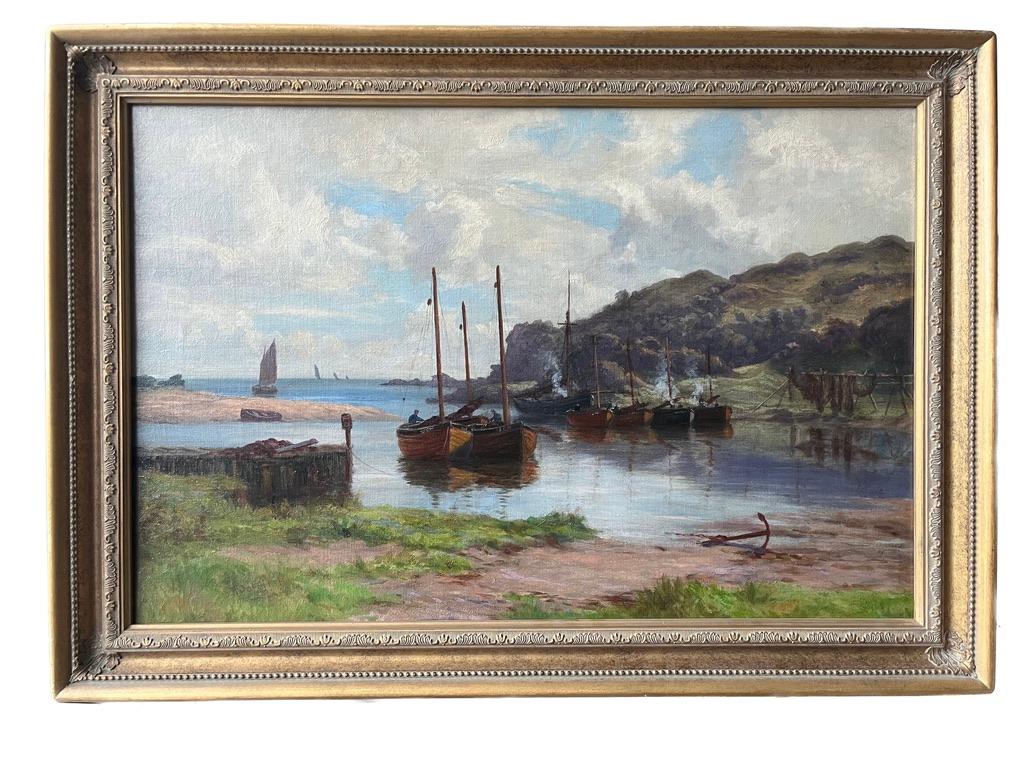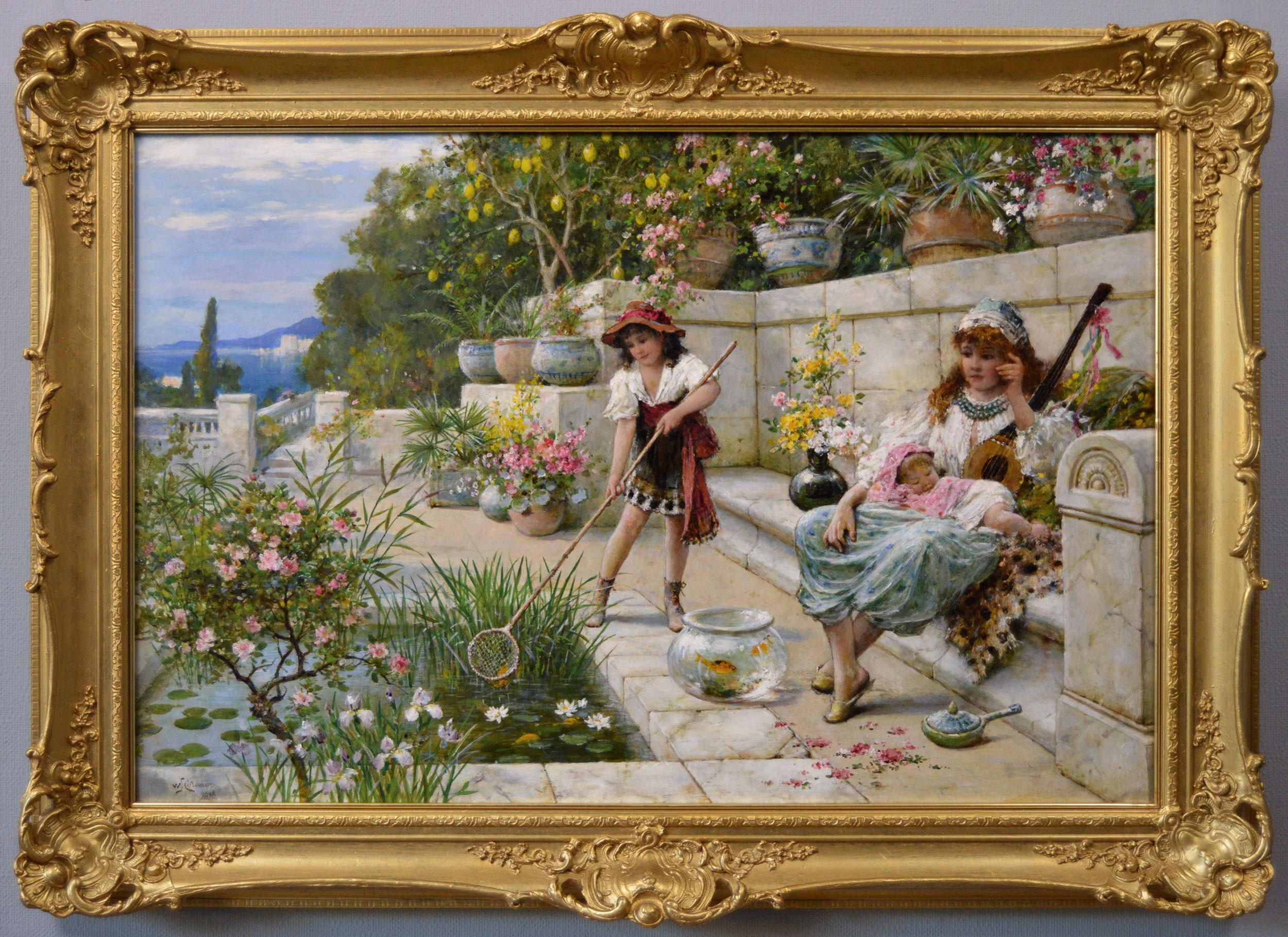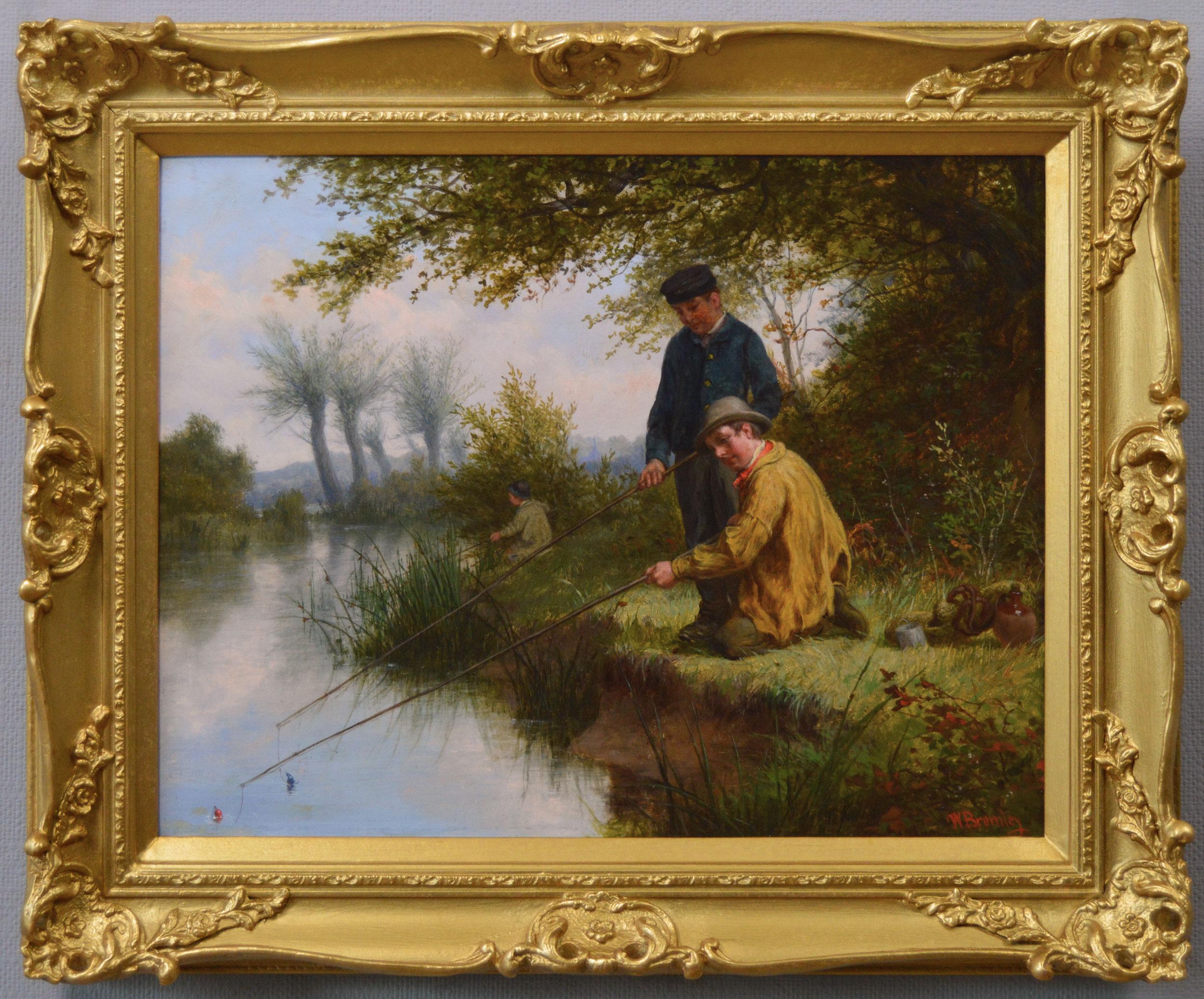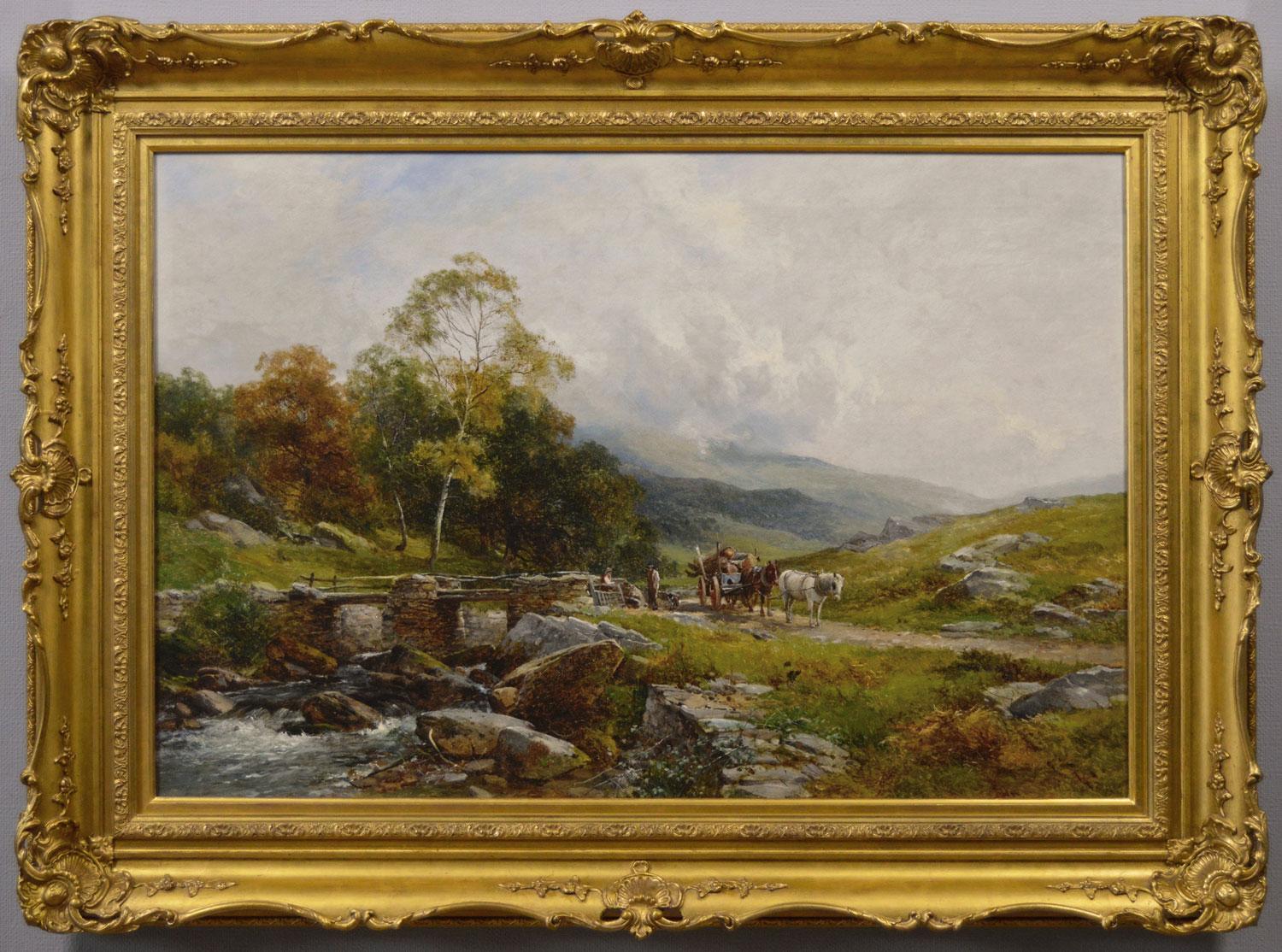Items Similar to A Day in the County - Large 19th Century Royal Academy Landscape Oil Painting
Want more images or videos?
Request additional images or videos from the seller
1 of 14
William Frederick WitheringtonA Day in the County - Large 19th Century Royal Academy Landscape Oil Painting1859
1859
About the Item
‘A Day in the Country’ by William Frederick Witherington R.A. (1785-1865).
The painting – which depicts a group of Victorian figures on a summer’s day before an extensive landscape of Wharfedale and the ruins of Bolton Priory – is signed by the artist and dated 1859, in which year it was exhibited at the Royal Academy.
Bolton Priory was originally founded in the 12th century as an Augustinian monastery known as Bolton Abbey. When King Henry VIII ordered the Dissolution of the Monasteries in 1539 the priory was abandoned and fell into ruin, but by the early 19th century interest in the Picturesque saw its Gothic ruins become one of the most popular destinations for Victorian day-trippers.
William Frederick Witherington entered the Royal Academy Schools in 1805. After making his debut at the Royal Academy in 1811, Withington exhibited there every year until 1863. Over the course of his long career, he found great success as a painter of well-executed pastoral landscapes and subject pictures in the manner of George Morland and David Wilkie. He was elected an R.A. in 1840. Between 1808 and 1863, Witherington exhibited 138 paintings at the Royal Academy and 62 at the British Institution.
Academy Fine Paintings only offers artwork for sale in the finest condition it can be for its age, having been professionally cleaned, conserved, and re-varnished. Clients should also note that tracked and signed for international shipping is complimentary.
Dimensions: (framed) 84cm x 110cm (33” x 43¼”)
Dimensions: (canvas only) 66cm x 93cm (26” x 36¼”)
Medium: Oil on canvas.
Provenance: 1859; exhibited at the Royal Academy (cat. no. 377. Private UK collection.
Presentation: Fine quality gold metal leaf frame.
Condition: Very good. Professionally cleaned, restored, and re-varnished. Ready to hang.
- Creator:William Frederick Witherington (1785 - 1965, British)
- Creation Year:1859
- Dimensions:Height: 33 in (83.82 cm)Width: 43 in (109.22 cm)Depth: 3 in (7.62 cm)
- Medium:
- Movement & Style:
- Period:
- Condition:
- Gallery Location:Gerrards Cross, GB
- Reference Number:1stDibs: LU741314202432
About the Seller
5.0
Vetted Seller
These experienced sellers undergo a comprehensive evaluation by our team of in-house experts.
Established in 2012
1stDibs seller since 2017
135 sales on 1stDibs
Typical response time: 5 hours
Associations
LAPADA - The Association of Arts & Antiques DealersInternational Confederation of Art and Antique Dealers' Associations
- ShippingRetrieving quote...Ships From: Gerrards Cross, United Kingdom
- Return PolicyA return for this item may be initiated within 3 days of delivery.
More From This SellerView All
- Arrest of Louis XVI & Marie Antoinette at Varennes - 19th Century Oil PaintingBy Robert Alexander HillingfordLocated in Gerrards Cross, GB‘The Arrest of Louis XVI and Marie Antoinette at Varennes’ by Robert Alexander Hillingford (1828-1904). The painting – which depicts the King and Queen of France’s failed attempt to...Category
Late 19th Century Victorian Figurative Paintings
MaterialsOil
- Mount Snowdon - 19th Century Royal Academy Welsh Mountain Oil Painting LandscapeBy Edward Charles WilliamsLocated in Gerrards Cross, GB‘Llyn Gwynant and Mount Snowdon’ by Edward Charles Williams (1807-1881). The painting – which depicts figures seated on the lake shore before the iconic Mount Snowdon (Yr Wyddfa) i...Category
1860s Victorian Landscape Paintings
MaterialsOil
- Carnevale di Venezia - Large 19th Century Oil Painting of Venice Carnival ItalyBy James HollandLocated in Gerrards Cross, GB‘Carnevale di Venezia’ by James Holland RWS (1799-1870). The painting – which depicts an extensive view of the Grand Canal with hundreds of masked revellers before the Ducal Palace ...Category
Mid-19th Century Victorian Landscape Paintings
MaterialsOil
- Carnevale di Venezia - Large 19th Century Oil Painting of Venice Italy CanalettoBy James HollandLocated in Gerrards Cross, GB‘Carnevale di Venezia’ by James Holland RWS (1799-1870). The painting – which depicts an extensive view of the Grand Canal with hundreds of masked revellers before the Ducal Palace ...Category
Mid-19th Century Victorian Landscape Paintings
MaterialsOil
- Mount Snowdon - 19th Century Royal Academy Oil Painting Welsh Mountain LandscapeBy Edward Charles WilliamsLocated in Gerrards Cross, GB‘Llyn Gwynant and Mount Snowdon’ by Edward Charles Williams (1807-1881). The painting – which depicts figures seated on the lake shore before the iconic Mount Snowdon (Yr Wyddfa) i...Category
1860s Victorian Landscape Paintings
MaterialsOil
- Before Glyder Fawr - Large 19th Century Welsh Mountain Landscape Oil PaintingBy John SyerLocated in Gerrards Cross, GB‘Before Glyder Fawr’ by John Syer RBA RI (1815-1885). The painting – which depicts the famous Welsh mountain in Snowdonia – is signed by the artist and dated 1876. Academy Fine P...Category
1870s Victorian Landscape Paintings
MaterialsOil
You May Also Like
- Victorian landscape painting of the River Thames with horses wateringBy Edwin Henry BoddingtonLocated in Harkstead, GBA very atmospheric scene of a horse and cart crossing the river Wey (a tributary of the river Thames) under a beautiful twilight sky. There is wonderful detail and light with the ar...Category
19th Century Victorian Landscape Paintings
MaterialsOil, Canvas
- Victorian landscape painting of Scottish fishing boats moored in a bayLocated in Harkstead, GBA very tranquil scene of fishing boats moored in harbour with a sunlit sea beyond. Painted with a most attractive palette of blues and greens and with a pleasing composition that le...Category
19th Century Victorian Landscape Paintings
MaterialsOil, Canvas
- 19th Century seascape oil painting of Penzance harbour, CornwallBy William Edward WebbLocated in Moreton-In-Marsh, GloucestershireWilliam Edward Webb British, (1862-1903) Penzance Harbour Oil on canvas, signed Image size: 29 inches x 45.5 inches Size including frame: 38 inches x 54.5 inches A pleasing coastal painting of Penzance Harbour at low tide by William Edward Webb. In the foreground, a fisherman sells his catch to a woman and her daughter, whilst figures in horses and carts wait for others to unload their boats. William Edward Webb was born in Cheltenham, Gloucestershire in 1862 to William Benjamin Webb and Ellen Butler. His father was a printer and an artist and it is highly likely he received tuition from him. Following the death of his mother, his father remarried and moved the family to Manchester sometime after 1871. By the 1880’s, Webb had started working as an artist and later set up a studio at 30 Exchange Buildings in Manchester. He began exhibiting at the Manchester City Art Gallery from 1890, where he showed more than 60 paintings during his lifetime. He also exhibited at the Royal Academy and Walker Art Gallery Liverpool from 1892. He married Clara Foster in 1899 and the couple lived at 1 Sylvan Grove, Chorlton Upon Medlock in South Manchester with their daughter Florrie. He became friends with the artist Walter Emsley (1860-1938) who also lived in Manchester. Although he spent the rest of his life in Manchester, Webb travelled throughout the UK painting coastal and marine scenes around the main ports and harbours. He spent a great deal of time in the Isle of Mann painting numerous scenes along the coast including views of Peel and Douglas Harbour, subjects he frequently returned to. Webb painted in a highly distinctive style; loose and informal but which manages to retain the sense of perspective. He struggled with ill health and depression throughout his life which sadly led to his suicide 9 November, 1903. In 1974, a retrospective exhibition was held at The Old Customs House and Old Solent House in Lymington, which brought a new found interest in his work. His paintings are now highly sought after and are represented in many collections and Museums including the Astley Hall...Category
19th Century Victorian Landscape Paintings
MaterialsOil, Canvas
- 19th Century genre oil painting of a woman in a garden with two girlsBy William Stephen ColemanLocated in Moreton-In-Marsh, GloucestershireWilliam Stephen Coleman British, (1829-1904) By the Fish Pond Oil on canvas, signed & dated 1898 Image size: 23 inches x 35 inches Size including frame: 30.25 inches x 42.25 inches A beautiful painting by William Stephen Coleman of a woman with two girls in a semi classical style by a Mediterranean pond. The woman is depicted resting on a terrace with her young daughter asleep on her lap, whilst another child catches goldfish in a bowl. This tour de force would have most likely been painted by Coleman as an exhibition piece. William Stephen Coleman was a figurative painter who was born in Horsham in 1829. He was one of 12 children born to a physician named William Thomas Coleman and his wife Henrietta (née Dendy). Three of his siblings Rebecca Coleman (b1837), Helen Cordelia Angell (1847–1884) and George Coleman also became artists, inheriting their artistic talent from their mother’s side of the family. Coleman developed an interest in nature from an early age, producing drawings as a hobby. Despite his ability, he initially followed in his father’s footsteps and trained as a surgeon. However, this proved unsuccessful and by the age of 21 he had turned back to art, later gaining employment with the Dalziel Brothers, a firm of wood engravers who specialised in natural history illustrations. Sometime during the late 1850’s he moved to London where he married his first wife Henrietta Augusta Boultbee in 1858. Around the same time, he began producing illustrations for books; the first of which was entitled ‘Common Objects of the Country’ and published in 1858. He subsequently published two of his own books ‘Our Woodlands. Heaths, and Hedges’ in 1859 and ‘British Butterflies’ in 1860. After the death of his wife in 1860, his sister Rebecca and brother George went to live with him in Garway Road, Paddington. Rebecca would often assist him with the wood blocks for his illustrations. As well as working as an engraver, he also began producing classically influenced paintings featuring figures in landscapes. Initially these were executed in watercolours but later extended to oil paintings. He began exhibiting at the Dudley Gallery in 1865 and was one of the original committee members. He continued to exhibit there until 1879 and was a committee member up until 1881. By 1869, he had also begun to work on pottery decoration and in 1871 was asked by Minton’s to establish an Art Pottery Studio at Kensington Gore. Whilst at Minton’s, he produced figure designs for their ceramic ware. His sister Rebecca also worked at Minton’s and they moved to Belle Vue in Chelsea to be closer to the studio. From 1881, he lived at 3 St John’s Wood Studios, Queens Terrace in Paddington and in 1888 moved to 43 Broadhurst Gardens in Hampstead. In 1893 one of his classically inspired works ‘The Gold Fish Bowl...Category
19th Century Victorian Figurative Paintings
MaterialsOil, Canvas
- 19th Century genre landscape oil painting of three boys fishing on a riverBy William BromleyLocated in Moreton-In-Marsh, GloucestershireWilliam Bromley British, (1816-1890) Gone Fishing Oil on canvas, signed Image size: 13.5 inches x 17.5 inches Size including frame: 18.75 inches x 22.75 inches A picturesque genr...Category
19th Century Victorian Figurative Paintings
MaterialsOil, Canvas
- 19th Century Welsh landscape oil painting of figures by the River GlaslynBy David Bates b.1840Located in Moreton-In-Marsh, GloucestershireDavid Bates British, (1840-1921) Early Morning on the Glaslyn Oil on canvas, signed & dated 1895, further inscribed verso Image size: 23.25 inches x 35.25 inches Size including fra...Category
19th Century Victorian Landscape Paintings
MaterialsOil, Canvas





